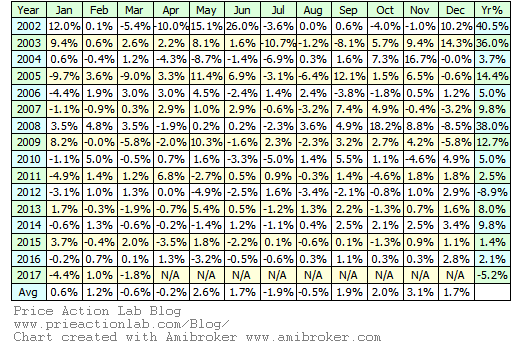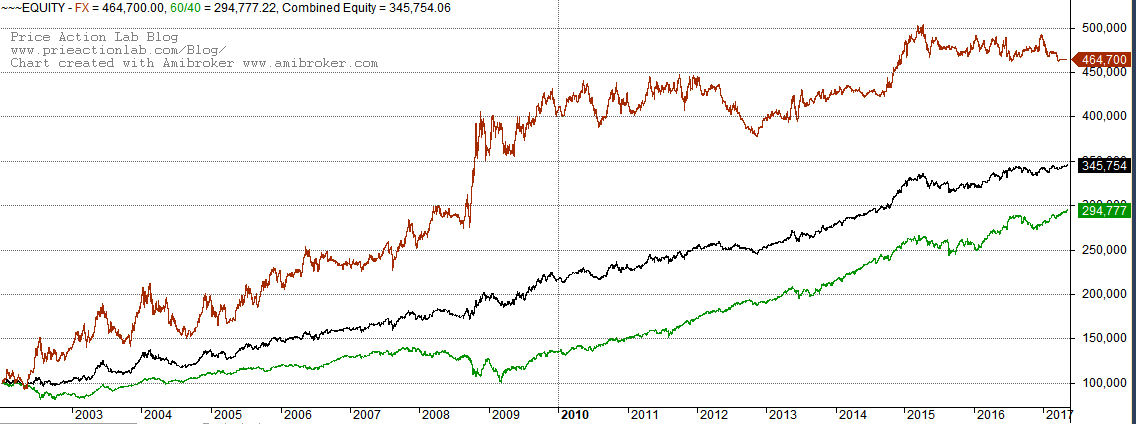Using a forex strategy in tactical asset allocation offers the potential of better diversification and improved performance during bear equity markets but any benefits from this allocation scheme must be weighed against known and unknown risks.
This subject is broad and encompasses a large spectrum of strategies. In a blog article, we can only present an example. In financial markets, for every advantage realized there is the risk of a hidden disadvantage and that is not always evident from start. Although some claim trends form in the forex markets due to persisting fundamental factors, detecting a trend and profiting from it is not equivalent. In addition, protracted choppy forex markets can result in accumulated losses in the case of trend-following strategies. Therefore, the risks must be understood and weighed carefully. This type of tactical asset allocation is only suitable for quantitative traders and investors. Trading the forex markets is a challenging task because quite often profits from long-lasting uptrends or downtrends can evaporate in a few days. But the beauty of the forex markets is in its liquidity and ease of shorting. Leverage is usually thought of as an advantage but it is also a major source of risk of ruin.
In the example below we consider a portfolio of six major currency pairs. Our objective is to study performance and we will not reveal the specifics of the strategy because it is proprietary although fundamentally simple. However, we hope that the information will be useful. This is a trend-following strategy and as a result impact of commissions is minimum.
Strategy details
- Forex pairs: EUR/USD, AUD/USD, GBP/USD, USD/CAN, USD/CHF, USD/JPY
- Initial strategy capital: $100K
- Position size: One standard lot per currency pair, fixed
- Signals: long and short (stop and reverse)
- Backtest period: 01/2002 to 03/2017
- Timeframe: daily
Performance
Strategy CAGR is 10.6%, maximum drawdown is 29%, and Sharpe is 0.62. A total of 204 trades were generated. The average holding period is 141 days and the win rate is 45%. The strategy uses at most 12% of initial capital as margin. There is no pyramid of positions. Below are charts of the equity curve and underwater equity.
Below is a table of monthly returns.
It may be seen from the above table that for 2008 the strategy return was 38%. The potential of outperformance during bear stock markets is where the value in considering forex as an asset class lies. With a hypothetical allocation of 10%, the gain from adding this forex strategy to a portfolio would be less than 4% in 2008. Still, this is a positive return during a time when the SPY total return was -34%. Additional asset classes can provide incremental improvement to counter-balance negative equity and also bond returns during periods of bear markets.
For example, the total return of the popular 60/40 stocks/bonds allocation in 2008 was about -9%. Including forex and other asset classes and strategies could have turned this loss into a gain. In the case of hedge funds, delivering positive returns in the year of a market crash often translates to a substantial increase in assets under management and publicity.
Below is a chart of the combined equity curve of an allocation scheme that invests 70% in the 60/40 portfolio and 30% in the forex strategy discussed.
It may be seen that the equity curve smoothing of the 60/40 portfolio is significant and the combined scheme outperforms the annually rebalanced 60/40 portfolio in SPY and TLT despite flat performance in forex over the last two years.
Finally, a Monte-Carlo simulation shows there is a 5% probability of a drawdown greater than about 44% for the forex strategy. However, this test may be flawed in the case of long-short strategies because it destroys this essential condition. In effect, results may be either too conservative or too optimistic but rarely realistic.
Conclusion
In the article, we presented the results of a simple trend-following strategy for a portfolio of six major currency pairs. Using alternative asset classes and also different strategies, such as long/short equity, can significantly enhance returns, especially during periods of equity market turmoil. However, these strategies are not suitable for individual investors but only for quants and hedge funds. Most individual investors are usually better off consulting a competent financial adviser rather than trying to get involved in a complex game of this sort that has many pitfalls.
Disclaimer: The premium articles are provided for informational purposes only and do not constitute investment advice or actionable content. We do not warrant the accuracy, completeness, fitness, or timeliness for any particular purposes of the premium articles. Under no circumstances should the premium articles be treated as financial advice. The author of this website is not a registered financial adviser. The past performance of any trading system or methodology is not necessarily indicative of future results. . Read the full disclaimer here.











